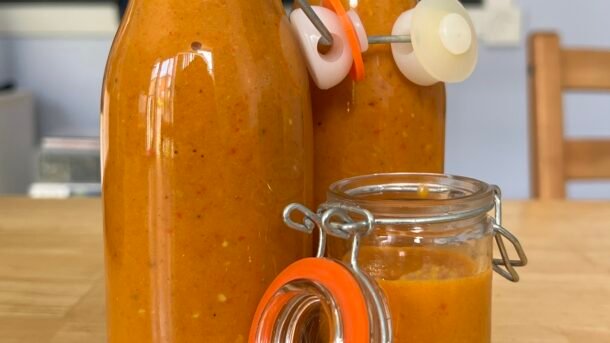Let me warn you now: this recipe will produce an extremely hot sauce, and the objective will be to make the flavour of the peppers the star of the show.
Another warning: as you prepare the sauce, you’ll almost certainly notice that the fumes are strong and irritating. I always prepare mine outside. If you can’t do that, make sure that you cook on the back burner to give your fume hood exhaust a fighting chance.
And now a suggestion: Latex gloves will be your friends as you chop your peppers. I promise you that the LAST thing you want to do is to find out the hard way that you’ve still got hot pepper residue on your fingers.
Also, there’s this: I have a separate set of prep tools for pepper sauce. What I said about pepper residue on your fingers goes just the same for pepper residue on utensils and cooking equipment. No matter how well you clean that blender, there’s always a possibility that you’ll wind up with a spicy milk shake the next time you use it. No-one ever really wants a spicy milk shake, no matter what they tell you.
Ingredients:
15 or 16 hot peppers, roughly chopped
10 or 12 Thai dragon chili peppers, roughly chopped
½ of a small onion, finely chopped
¼ of a large bell pepper, finely chopped
½ of a small tomato, finely chopped
3 (or more to taste) cloves of garlic, minced
juice of one large lemon and one small lime—strain out the pulp and mind the seeds!
2 tablespoons of vinegar
1 tablespoon of yellow mustard
2½ tablespoons of extra-virgin olive oil
½ tablespoon of Szechuan peppercorns, toasted and crushed
¼ teaspoon of allspice
a pinch to ¼ teaspoon of salt (optional)
¼ teaspoon of cumin (optional)
¼ teaspoon of smoked paprika (optional)
Other things you’ll need:
a sharp knife
cutting board
blender or food processor (anything with a “puree” setting)
10” frying pan
wooden spoon or plastic spatula
funnel
a few swing-top bottles (I like to use the small ones from the dollar store)
On to business!

This is the easy part. The nuance comes later when you read through the notes. That’s where you get to make some decisions about experimentation with flavour profiles. I’ll explain what my default settings are and walk through some interesting options that you might want to consider when you try making your sauce(s).
- set your pan onto your heat source and get it to medium-low temperature—if your dial goes from zero to ten, you want about a four
- pour your first ½ tbsp of olive oil into the pan
- sauté your onions, garlic, and all the peppers until the onions are translucent and soft and all the rest of the veggies are mushy
- this part should not take much longer than five or six minutes
- take your pan off the heat and give your veggies a few minutes to cool down
- put all your veggies into the blender and add the remainder of the ingredients to the mix
- purée until your mixture is smooth and the oil has been emulsified (that’s what the mustard is for!)
- you can also add up to about ⅓ of a cup of water to your sauce to make the liquid run a little bit more freely (I promise that the sauce will still be hot enough for most tastes)
- I’ll usually walk away for at least a minute or two to make sure that I’ve mixed everything thoroughly
- if a layer of oil begins to form up on top of your sauce, mix it some more
- here’s where you get to take the first taste of your sauce!
- take the lid off your blender or food processor and put your sauce someplace safe for about ten minutes to allow it to cool
- now’s the time that you can bring your sauce inside if you were outside the house while preparing it
- you can also take the time to clean some of the other stuff you used to prepare your veggies
- pour your sauce into your swing top bottles and leave them uncovered until the sauce reaches room temperature
- only after they have cooled will it be time to close the bottles and store them in the fridge
- because of the acidity in the vinegar and the lemon juice, your sauce should last you at least six months (unless you use it all before then!)

Notes:
First, this is a long-ass recipe, especially considering that the notes that describe the actual preparation of the sauce take up such little space. I promise you that the rest of the notes are worth it!
The Hotter Peppers
I typically will use one of four kinds of hot peppers to make my sauce (I used to also use Trinidad Moruga scorpion peppers, but I realized that they just bring shocking heat with almost no flavour, and that’s not what I want in my sauces). If you want to try to make your sauces somewhat milder (ha!), remember that it’s not the seeds that are the hottest parts of the plant. The white pith and ribs carry the most heat, so scoop those parts away if you want to try to spare your taste buds.
- Scotch bonnets are my absolute favourite when it comes to flavour. It’s a unique fruity, earthy, slightly citrus-y, tropical taste that should come through before the heat explodes in your mouth.
- Habañero peppers will give a fruity, floral, and sweet scent and flavour to your sauce.
- Ghost peppers should give a very fruity and sweet flavour. Also, they’ll be (on average) about three times as hot as the scotchies or the habaneros.
- Carolina Reapers give a fruity and sweet flavour with a bit of a citrus tang. They will also double the heat of the ghost peppers. But once you get past a certain heat level, does it even matter anymore?
The Other Peppers
The Thai dragon chilies and the bell peppers are there mostly for volume. The dragon peppers lend a fruity/earthy hint of flavour while the bell peppers will have a much milder impact. Green or purple bells will give a slightly bitter tang, whereas the orange, yellow, and red fruit will be sweeter. Another point to consider here is that the colour of the sauce will be affected by the skins and flesh of the peppers you choose to add. Just saying.
The Onion
I will typically use white onions. They’re sweeter in flavour than most people think. Use yellow onions for a more intense onion kick and more sweetness. Use red/Spanish onions for a somewhat spicier kick.
The Tomato
My go-to varietal is Roma tomatoes, mostly because we’ll often already have the plants growing in the garden for salsa. But they also offer a bit of full, fresh, tangy flavour. For some tartness, use green beefsteak tomatoes. A couple of cherry tomatoes adds the same kind of sweetness you might expect from candy.
The Vinegar
I use plain old white vinegar most of the time. Apple cider vinegar gives a nice sweet-and-sour punch. Malt vinegar gives a lemony, malty finish. I would stay away from malt vinegar unless you already like that flavour. I’m not a fan myself.
The Oil
Olive oil can be slightly bitter and peppery in the back of the throat, which is what makes it such an interesting choice in pepper sauce. I will occasionally use garlic-infused olive oil for some added pungency. Canola oil is another option—it’s a milder and less flavourful oil, but it’s a good emulsifier and almost as healthy as olive oil.
The Extra Spices
A little bit of spice goes a very long way. The ones I tend to favour will add some interesting notes to your sauce. Cumin will add an earthy, rich, and hearty depth while smoked paprika, while peppery in its own right, will provide a smokiness to your final product. Salt is salt and everyone knows what it tastes like, but adding table salt to pepper sauce has much more impact than you might think. If you choose to use it, ¼ teaspoon might almost be too much. Start with a pinch and adjust to taste.
Good luck!


